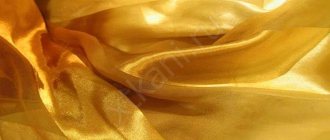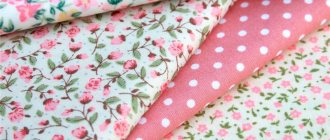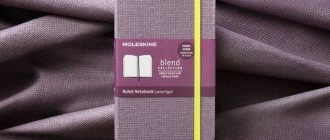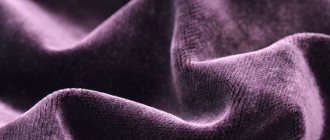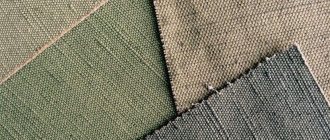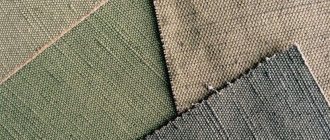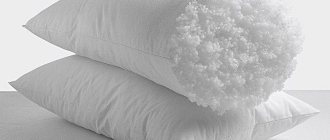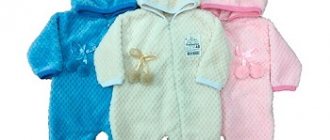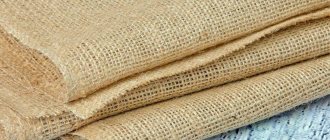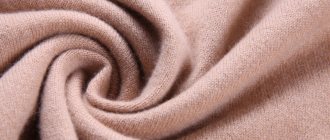Nylon - (poly-caproamide, nylon-6, polyamide 6) - is a thin, dense material from transparent to yellowish, the material has a slight characteristic shine. This is a very durable, wear-resistant and lightweight fabric, easy to care for, and does not change its properties when exposed to moisture.
“Nylon is a synthetic polyamide fiber obtained from petroleum, very strong: a nylon thread with a diameter of 0.1 millimeters can withstand a weight of 0.55 kg. The elasticity of nylon is much higher than silk. Abroad, synthetic fiber such as nylon is called peron and nylon. Nylon is produced in several grades; along with high strength, nylon fibers are characterized by resistance to abrasion and repeated deformation. The material does not absorb moisture and does not lose its strength when wet. When heated, its strength decreases and melting occurs at 215 degrees. Nylon is used to make ropes, fishing nets, fishing line, cord fabric, stockings and other household goods. Also, clothes are made from this material, which are much cheaper than clothes made from natural materials.” Wikipedia
Nylon material
Nylon is made by hydrogenating phenol. Typically, the oxidation formula of isopropylbenzene is used. Oxidation is made possible by two elements: propylene and benzene. The raw materials are petroleum products from which caprolactam is produced, from which polycaproamide is obtained. After this, fibers are produced from the products, which serve as the basis for the production of nylon.
Products made from nylon thread are characterized by high strength, reliability and are very durable. They adequately withstand intense loads, as well as various physical and mechanical impacts. Thanks to its excellent performance characteristics, nylon clothing will last for many years and will not change its presentable appearance.
Flaws
Nylon, like all synthetics, has a lot of disadvantages. Firstly, the material is not hygienic. It does not provide the necessary air exchange, does not absorb moisture and sometimes irritates the skin. Secondly, the material is afraid of high temperatures and chemical reagents, although it is tolerant of acids and alkalis. It is prone to melting, and therefore they try not to iron it. Also, nylon fibers do not hold color well in light, that is, they are afraid of ultraviolet radiation.
Nylon accumulates static electricity, which requires special treatment before wearing. Synthetics are no different in thermoregulation, but they can improve the characteristics of natural materials. For example, a combination of wool and nylon provides sufficient thermal insulation and protection from the wind.
Nylon production
The production process of producing nylon thread occurs in several stages. As a result of the polymerization of caprolactam, a thick gel is formed - this is an explosive substance; enterprises and factories that produce caprone require increased attention to safety. Polymerization is performed at a temperature of 270 degrees. To produce nylon threads, special equipment is used, through which the threads are pressed from the gel. The resulting substance is cooled, formed into a ribbon, crushed, and then the remaining water is evaporated and the granules are dried. The raw materials are melted until a liquid state is obtained, after which they are sent to molding machines, which produce threads according to specified parameters. After time, the threads turn into matter. Next, the threads are stretched industrially and sent to weavers.
The history of nylon
The history of nylon begins in 1938, in Germany Paul Schlak first synthesized polycaprolactam as a polymer to produce polyamide fiber, it was called perlon. Pal Schlak worked for IG Farben in Germany. In 1943, polycaprolactam production was established on an industrial scale. At that time, more than 3.5 tons per year were produced using phenol feedstock. Initially, coarse nylon threads were produced, which were used as artificial bristles. After a while, they began to produce parachute silk based on polycaprolactam, as well as cord for aircraft tires and towing ropes for gliders.
In the USSR in 1942, Rymashevskaya Yu.A., as well as Knunyants I.L. and Rogovin Z.A. made a discovery: they demonstrated the possibility of polymerizing caprolactam into a linear polymer; 5 years later they carried out work on the synthesis of fiber-forming polyamides, as a result of which they analyzed the conditions for the rearrangement of oximes into caprolactam. Thus, they identified the optimal conditions for the polymerization of lactams and the purification of polyamide from the monomer. The first production of polycaprolactam was opened in the USSR in 1948. It should be noted that fiber made from polyamide resins in Russia is called nylon and anide; in terms of their performance and technical characteristics, they practically do not differ from each other.
Since 1960, nylon has become more popular and is widely distributed both in Russia and in the world. This material is beginning to be produced on an industrial scale, and fabric made from aromatic heat-resistant polyamides is beginning to be used. Nylon thread is being produced from a polymer - polycaproamide. This was a real breakthrough in the production of this material; due to aminocaproic acid, which was the main component in the composition of this fiber, a substance was created that was called nylon.
Today, nylon is still relevant and in demand. Various household items, fishing nets, and fishing line are made from it. This material is especially in demand for sewing tights and stockings. These products are characterized by increased strength, reliability and incredible wear resistance. Thanks to its amazing performance properties, nylon thread is used for the production of clothing; its quality is not inferior to synthetic materials, but it is more accessible and has a low cost. In addition, nylon is used in a wide variety of production areas, for example, frames and car tires are made from this fabric. They are extremely reliable, durable, designed for intense loads and withstand physical and mechanical stress.
Areas of application
The properties of nylon fabric are discussed. Now we need to mention the areas of its application. It is used not only to create nylon stockings, tights, and socks. The material is widely used for:
- creating clothes. Previously, various wardrobe items were made from fabric. In modern times, decorative elements are also made from it, such as lace inserts;
- creating stage costumes. Kapron is especially popular in sewing outfits for various sports competitions: figure skating, gymnastics, ballroom dancing, etc.
Curtains are made from the fabric, and it is used to filter water.
Adhesive dublerin - what kind of fabric is this? Properties and application of the material
Types of nylon
To make nylon, various methods of weaving threads are used:
- linen;
- twill.
When the threads are weaved in plain linen, a strong and thin fabric is obtained. This type of nylon is widespread and is one of the most popular. Tights, stockings are sewn from it, fishing line and other products are made. This material is characterized by high strength, is very durable and can withstand physical and mechanical stress.
A distinctive feature of twill weave is the raised ribbed surface. This fabric is of high quality, incredible strength and is used in various fields of production.
Nylon thread differs in the method of dyeing:
- plain;
- with an image.
Plain threads are considered the most versatile and classic. Products made from these materials go well with almost any style and are in great demand.
Patterned nylon threads are produced in various colors: blue, red, green, yellow, as well as pastel colors and acid colors. Today, bright colors are also in demand; they emphasize individuality and skillfully transform the image.
Nylon threads are usually produced with a smooth surface, but there is another type - flocked material. It is made using a special technology, the surface of this material is velvety. It is very pleasant to the touch and symbolizes status and prosperity. This type of nylon is gaining popularity; it is characterized by high strength, is very durable and can easily withstand various physical and mechanical influences.
Brands produced by industry
At the present stage, the chemical industry produces several types of polyamides. The largest group is represented by aliphatic polyamides. They are divided into the following groups:
Crystallizing homopolymers:
- polyamide 6 (PA 6), known as caprolon;
- polyamide 66 (PA6.6) or polyhexamethylenadinamide;
- polyamide 610 (PA 6.10) whose name is polyhexamethylene sebacinamide;
- polyamide 612 (RA 6.12);
- polyamide 11 (PA11) - polyundecanamide;
- polyamide 12 (PA12) - polydodecanamide;
- polyamide 46 (RPA46) and polyamide 69 (PA69).
Crystallizing copolymers:
- polyamide 6/66 (PA6.66) or PA 6/66;
- polyamide 6/66/10 (RA 6/66/10);
- thermoplastic polyamide elastomer (polyetherblockamide) - TPA (TPE-A) or REVA.
Amorphous
- polyamide MASM 12 (RA MASM12);
- polyamide RASM (RA RASM 12).
The second, no less common group is aromatic and semi-aromatic polyamides (PAA). They are divided into:
Crystallizing:
- polyphthalamides (synthesized from isophthalic and terephthalic acids), labeled: PA 6T; PA 6I/6T and PA 6T/6I; PA 66/6T and PA 6T/66; PA 9T HTN;
- polyamide MXD6 (PA MXD6).
Amorphous
- polyamide 6-3T (PA 63T; PA NDT/INDT).
Another group of polyamides is glass-filled. They belong to composite materials (modified polyamides), in which glass beads or structured threads are added to the resin. Common brands of glass-filled polyamides: RA 6 SV-30; RA6 12-KS; RA 6 210-KS; RA 6 211-DS, where
- SV - glass fiber, 30 - its percentage;
- KS - granule length less than 5 mm;
- DS - granule length from 5 mm to 7.5 mm.
The following are also used as modifiers:
- talc (deformation marks);
- molybdenum disulfate (increases wear resistance and reduces friction);
- graphite.
Trade organizations offer polyamides under various commercial names: nylon, Ultramid, Ultralon, Zutel, Duerthan, Sustamid, Akulon, Ertalon, Tekamid, Tekast, etc. But they all represent the brands listed above. For example, Tecamid 66 is Polyamide 66.
The advantage of nylon
- high strength and reliability (nylon thread with a diameter of 0.1 mm can withstand a load of 0.55 kg)
- increased resistance to abrasion (nylon retains its texture and attractive appearance throughout its entire service life);
- wear resistance (the material adequately withstands intense loads, various frictions and torsions);
- elasticity (dry nylon can stretch by 20-25%;
- synthetic fiber nylon has good water-repellent properties and practically does not get wet;
- this material is resistant to mold, moths, rotting and harmful microorganisms;
- easy to process and dye (thanks to this property, you can find nylon products in a wide variety of colors);
- light weight (approximately 20-60 g/sq.m.;
- nylon holds its shape perfectly, and after unscrewing it returns to its original state;
- not susceptible to extreme temperatures (can withstand temperatures as low as -70 degrees);
- resistance to alkalis and oxidizing agents;
- wide distribution and availability throughout the world;
- relatively low cost (this has a positive effect on the demand for nylon products);
- absolutely safe to use;
- hypoallergenic;
- practicality (nylon fiber does not require maintenance);
- durability (the material is able to withstand maximum loads; with timely care and careful treatment, nylon will last for many years).
Properties of synthetic fibers
Why do we love clothes made from natural materials?
Yes, it does not cause allergies, the body breathes easily in it, it has good water permeability, it is not hot in summer and warm in winter, it is pleasant to the body.
But synthetic fabrics also have their advantages, because it was the beneficial properties of this material that were incorporated during its creation. People have learned to create materials with the characteristics they need, and in many respects even superior to products made from natural fabrics.
Advantages of synthetic fabrics:
- Does not shrink, does not deform when washed;
- Keeps shape well;
- They have low cost and price;
- Highly durable;
- Wear-resistant;
- Drapes well;
- Retains its original appearance for a long time;
- They wrinkle slightly and rarely require ironing;
- Lungs;
- Resistant to external influences (mechanical, sunburn, chemicals);
- They have a huge variety of colors;
- Not susceptible to damage by pests (moths, fungi, etc.);
- They have a permanent color;
- They do not absorb moisture well and dry quickly;
- Easy to wash, easy to care for.
Disadvantages of synthetics:
- Does not breathe: does not allow air and moisture to pass through;
- May cause allergic reactions in contact with skin;
- Electrified;
- Doesn't keep you warm in the cold.
Fabric manufacturers have learned to correctly use all the pros and cons, creating many varieties of materials for various purposes.
How to care for nylon
Nylon is considered an undemanding material, however, certain care rules must be followed in order to extend the life of products made from this fabric. Before washing, you should read the label on the product, which contains basic care instructions.
How to wash nylon
You can wash nylon items by hand or in a machine. To do this, you need to set the washing machine to the “delicate” or “synthetic” mode. The recommended washing temperature should be 30-40 degrees. A good solution would be to use liquid detergents designed for synthetics. Do not bleach with chlorine or other aggressive detergents. They can have a negative impact on the fiber structure and change the presentable and original appearance. In addition, it is forbidden to set the spin cycle at high speeds of the machine, as this may have a negative effect on the material.
How to dry nylon
After washing, nylon products must be dried thoroughly. Drying clothes is best done flat. It is best to hang nylon products in the bathroom and allow excess moisture to drain, or wrap nylon clothing with a terry towel, which will absorb excess moisture. In addition, products must be dried away from artificial heat sources and battery radiators. It is also not recommended to leave things to dry on the balcony: prolonged exposure to sunlight can change the rich color and shape of the items. Nylon begins to turn yellow from ultraviolet rays, and also loses its high strength and becomes unusable. It is necessary to dry nylon items in a ventilated area, under natural conditions.
How to iron nylon
Products made from nylon most often do not require ironing; if small wrinkles appear, you can use an iron. To do this, set the iron to “synthetic” mode and iron the product. A good solution would be to use light lining fabric or gauze.
How to store nylon
Before sending nylon products for storage, items must be washed and dried thoroughly. You can store them in a closet using a fabric cover, away from the radiator and other heat sources. Storage on the balcony should be avoided; prolonged exposure to sunlight has a negative effect on the shape, structure and color of the fabric. Before sending for long-term storage, it is necessary to treat it with special agents against harmful bacteria and moths.
So, nylon is a universal and unique material that has the ideal combination of price and quality. Today, nylon thread is also in demand and is in great demand. Various products are made from it; this material is used in fishing, in the manufacture of fishing lines and nets. In addition, nylon is used for sewing tights and stockings - an invariable wardrobe of any woman. This material is easy to paint and very convenient to process. Reasonable price, excellent performance, high quality and use in everyday life are the defining advantages of this material.
Care
For nylon, as for any other fabric, proper care is important:
- It is not recommended to wash this type of fabric at high temperatures. For washing, use the delicate cycle. Housewives recommend using a temperature of no more than 30 °C. But at 40 °C, nylon items also do not lose their positive qualities.
- You should not use bleach when washing; if necessary, just soak the item in soapy water.
- Be sure to ensure that the powder dissolves as much as possible.
- The item must be well rinsed, otherwise the product will lose color and brightness.
- The fabric is not spun or ironed. If it is necessary to iron the material, use low temperatures.
- If the item becomes dusty, it is best to use a vacuum cleaner.
- Avoid touching things with sharp objects.
Nylon tights
